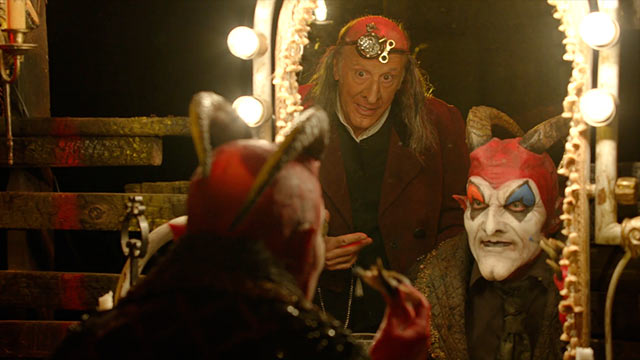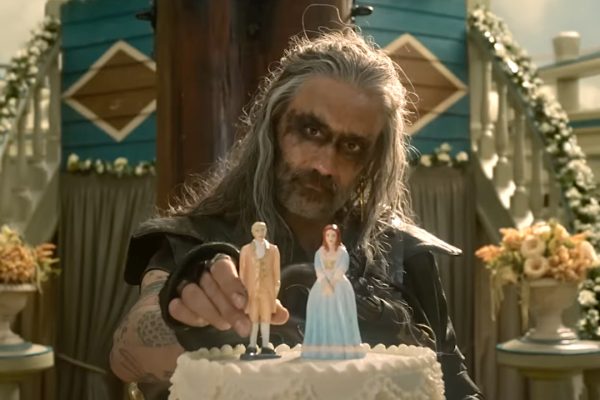The Beauty Of: The Devil’s Carnival
“The Beauty Of” explores… questionable media.
What can I say, I’m weak for bad musicals. And Terrance Zdunich is apparently a machine whose one function is to churn these out relentlessly. In The Devil’s Carnival, Zdunich is once again a major role; this time, he is Lucifer himself. As can be inferred from the title, he is also the ringleader in the carnival that is hell, employing his demonic carnies to torture damned souls. As with Repo, it’s certainly an interesting concept, but the plot is strange and shaky. One plus is that it is fairly short and does not have much room to get off track. This also works against it, however, as certain things seem very rushed or seem to come out of nowhere.
The basic plot is that three people die at around the same time and all arrive in hell at the same time. The first, Tamara, was shot by her boyfriend for refusing his advances. Her sin seems to be bad taste in men, which is pretty unreasonable, but Lucifer is not in charge of who gets sent where. The next is Ms. Merrywood, a thief of beautiful objects and jewelry. She was killed in a shootout with the police and her sins are vanity and greed. The last is named John, and he killed himself due to the grief he experiences from the loss of his young son. This will also impact what specifically his sin was, so it remains unclear. In any case, all three of these people end up in hell.
The other major characters are the demons. The more important ones are the Painted Doll, the Hobo Clown, the Scorpion, the Twin, and the Ticket-Keeper. The Ticket-Keeper is sort of Lucifer’s second-in-command, his secretarial assistant. These demonic entities all torment the mortals or poke fun at them in one way or another, and all have their own distinct song. Each sinner and their sin also relates to a specific fable, which are told through these songs.
Miss Merrywood sees an advertisement for an attraction that easily catches her eye: a very large diamond. She searches for it and finds the Twin, a shapeshifting carnie who says she can have the diamond if she wins a game against him. Here, the song “Beautiful Stranger” plays. He shapeshifts into her, and somehow she does not recognize that at herself. She loses the game(one where you toss things into another thing) and then is stripped of all her belongings. Then, she is whipped as the hobo clown sings “A Penny for a Tale”, which tells the fable of “The Dog and its Reflection”. The basic rundown of this is that a dog has a bunch of shiny pennies which it loves dearly, and then one day it sees its reflection in the water. The dog in its reflection also has pennies, and it tries to steal them, not knowing that the other dog is just its reflection. While doing this, it drops the pennies into the water, dives after them, and drowns. So, the similarities are clear. The other woman, Tamara, does not fare much better.
Tamara, upon seeing the Scorpion(a typical bad boy with slicked-back hair, a knife-thrower), instantly falls in love. She, dressed in a lovely green dress, takes the role of the frog in a retelling of the story of the Scorpion and the Frog. The original story goes something like this: A scorpion and a frog sit on one side of a river, and the scorpion asks the frog for a ride across. The frog is hesitant because it does not want to get stung, but the scorpion says that if it were to sting the frog they would both drown. The frog agrees and they are almost to the shore when the scorpion stings the frog, and sure enough they begin sinking. The frog, right before it dies, asks the scorpion why it would do that. “It’s in my nature,” it replies before it and its victim die.
The plot of the movie is of course, slightly different. The Scorpion asks Tamara to be on the wheel in his knife-throwing act, and she obliges as he sings a very suspicious song called “Trust Me” to her. In the middle, as she is being strapped to the wheel, she asks “How do I know you won’t stab me?” to which he replies, “Because my act would be dead without you.” Then, sure enough, by the end of the song she has a knife sticking out of her chest. The Scorpion, of course, is not really affected by this in any way. The only mortal left unharmed(mostly) by this point is John.
“Grief and His Due” is the story that John is loosely based off of. Really, it’s only connected in that it is about grief. John is searching for his son, who he believes is also in hell with him. He finds himself in a hall of mirrors, and so actually ends up tormenting himself. He even sings his own song during this scene, driving home the fact that he is torturing himself more than any demon could. At the end of the hall of mirrors, he ends up in Lucifer’s study, and the devil explains to John that he is in hell because he would not let go of his grief. When John finally says that he doesn’t want to grieve anymore, Lucifer sends him to heaven to the shock of God.
After this, Lucifer exits his study and addresses the other demons. He says that he has had enough of heaven’s strange policies about who gets redemption, and he intends to invade and take over heaven to improve hell. Overall, this film is incredibly strange. It was able to be so unique because the directors and writers chose to create and distribute it on their own, without help from other production companies. The only discernible message is something about the hypocrisy of organized religion, but that is explored more in its sequel: The Devil’s Carnival: Alleluia! This one is mostly introducing characters and setting. It’s not necessarily a great movie; the camera work is confusing, the cuts don’t make sense, and the plot is rushed and confusing. However,the music is enjoyable and the characters are compelling. The concept is also very interesting and the carnival vibes are fun. There’s sort of a joyous chaos about the whole thing that makes it really fun to watch. I highly recommend it if you’re lame and are comfortable with violence and negative commentary on organized religion.
Your donation will support the student journalists of The Tower and John Adams High School. Your contribution will allow us to purchase equipment and cover our annual website hosting costs.

Mag Blanchard is a senior at John Adams High School, and is spending her year writing for The Tower for the first time. She has been wanting to get into...












Ivy • Jan 6, 2022 at 11:42 am
Tamara’s sin was that she was too trusting, not just bad taste in men.